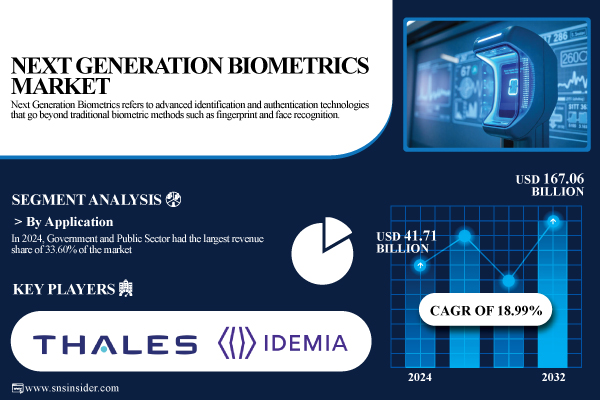The global Next Generation Biometrics Market is poised for significant growth, projected to expand from a value of USD 41.71 billion in 2024 to approximately USD 167.06 billion by 2032. This transformation, with an anticipated compound annual growth rate (CAGR) of 18.99% during the forecast period from 2025 to 2032, is driven by the increasing demand for enhanced security across various sectors, including government, banking, and consumer services.
According to a report by SNS Insider, the adoption of biometric technology is accelerating, fueled by innovations in consumer devices, enterprise authentication systems, and financial technology applications. Governments and enterprises are increasingly turning to contactless biometric solutions to bolster security measures while also improving user experience.
Market Dynamics and Sector Influence
The rising need for secure and efficient authentication methods is a key factor in the growth of the biometric market. Biometric systems are expected to reduce identity fraud by more than 50% compared to traditional authentication methods. In the United States alone, the biometric market is projected to reach USD 37.36 billion by 2032, driven by national security initiatives, border control operations, and early adoption within the banking and healthcare sectors.
The consumer landscape is also evolving, with around 65% of financial technology applications now offering biometric login options. This trend is stimulating further innovation in embedded sensors and software solutions.
Key Technologies and Applications
The report highlights fingerprint recognition as the dominant biometric technology, capturing a 34.20% market share in 2024. It is widely utilized in mobile devices, government identification programs, automated teller machines (ATMs), and access control systems due to its reliability and cost-effectiveness for large-scale implementation.
Facial recognition technology is recognized for its rapid growth potential, expected to achieve the highest CAGR of 20.21% through 2032. Its appeal lies in its contactless and swift verification capabilities, making it suitable for applications in surveillance, airport security, mobile authentication, banking, retail, and smart city initiatives.
In terms of application, the government and public sector led the market with a 33.60% share in 2024, driven by extensive deployments in national security, law enforcement, and civil administration. The National ID Programs segment is anticipated to grow the fastest, at a CAGR of 20.59%, as digital identity initiatives gain traction in regions including Asia, Africa, and Latin America.
Deployment models are also evolving, with on-premise solutions capturing a 24.60% share in 2024. However, cloud-based deployments are expected to grow rapidly at a CAGR of 21.95%, supported by the demand for scalable and cost-effective solutions.
Regional Insights and Future Outlook
In 2024, North America dominated the global biometric market with a 31.80% revenue share, largely due to substantial government investments in homeland security and border control. The region benefits from a strong technological infrastructure and numerous leading providers in the field.
Asia Pacific is projected to be the fastest-growing market, with a CAGR of 19.92%. Key drivers include digital transformation, government ID programs, fintech integration, and smart city initiatives, particularly in countries such as India, China, Indonesia, and the Philippines.
Europe remains a significant player, driven by secure identity verification requirements and regulatory compliance related to the General Data Protection Regulation (GDPR). Germany is at the forefront of border control and digital identity initiatives in the region.
Emerging markets in the Middle East and Africa, led by the United Arab Emirates, along with growth in Latin America, particularly in Brazil, are expanding through the adoption of biometrics in immigration, voting, banking, and smart city projects.
As the Next Generation Biometrics Market continues to develop, the emphasis on security, efficiency, and user experience will drive innovation and investment in this dynamic sector.
